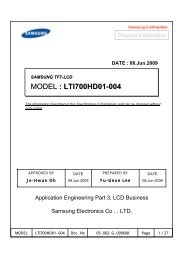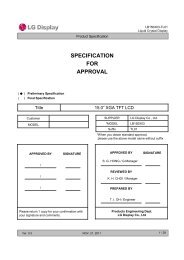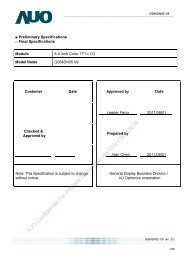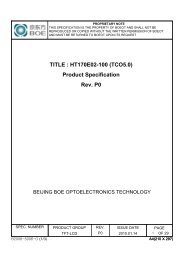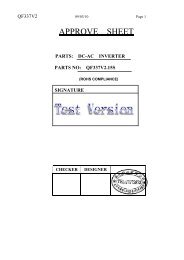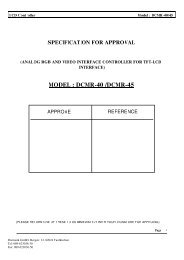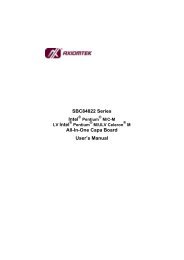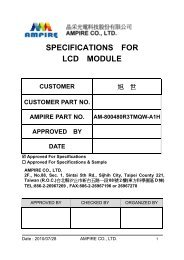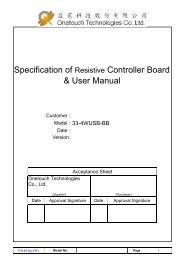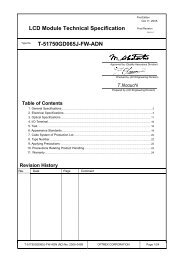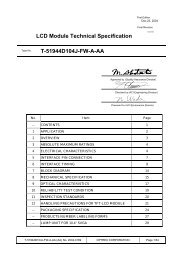SL4238ML-01 Bar LCM Specification
SL4238ML-01 Bar LCM Specification
SL4238ML-01 Bar LCM Specification
You also want an ePaper? Increase the reach of your titles
YUMPU automatically turns print PDFs into web optimized ePapers that Google loves.
<strong>Specification</strong><br />
Surpassing The BEST<br />
Systems Technology Inc.<br />
Model: <strong>SL4238ML</strong>-<strong>01</strong><br />
Version: 1.0<br />
Date: 06/05/2009<br />
Doc. No.: STI_DID_090220<br />
The Information Described in this <strong>Specification</strong> is Preliminary and can be changed without prior notice<br />
Signature Date<br />
Please return 1 copy for your information with<br />
your signature and comments<br />
Approved by Date<br />
Product Engineering Dept.<br />
Systems Technology Inc.
<strong>SL4238ML</strong>-<strong>01</strong> <strong>Bar</strong> <strong>LCM</strong> <strong>Specification</strong><br />
Revision History<br />
Date Rev. No. Page Description<br />
02/28/2009 0.0 First Draft<br />
06/05/2009 1.0 6, 7 Electrical characteristics confirm<br />
21 Environment test condition confirm<br />
Document No.: STI_DID_090220 Version 1.0<br />
Systems Technology Inc. Page 2 of 31
<strong>SL4238ML</strong>-<strong>01</strong> <strong>Bar</strong> <strong>LCM</strong> <strong>Specification</strong><br />
Contents<br />
Revision History .............................................................................................................................................. 2<br />
Contents ........................................................................................................................................................... 3<br />
1. General Description ................................................................................................................................ 4<br />
2. Absolute Maximum Ratings ................................................................................................................... 5<br />
3. Electrical <strong>Specification</strong>s ......................................................................................................................... 6<br />
3.1. Electrical Characteristics................................................................................................................. 6<br />
3.2. Interface Connections ..................................................................................................................... 8<br />
3.2.1. LCD Module...................................................................................................................... 8<br />
3.2.2. Backlight Inverter ............................................................................................................ 10<br />
3.3. Signal Timing <strong>Specification</strong>s...........................................................................................................11<br />
3.4. Signal Timing Waveforms.............................................................................................................. 12<br />
3.5. Color Data Reference ................................................................................................................... 13<br />
3.6. Power Sequence........................................................................................................................... 14<br />
3.6.1. LCD Driving circuit .......................................................................................................... 14<br />
3.6.2. Sequence for Inverter ..................................................................................................... 15<br />
3.6.3. Deep condition for Inverter ............................................................................................. 15<br />
4. Optical <strong>Specification</strong>............................................................................................................................. 16<br />
5. Mechanical Characteristics .................................................................................................................. 19<br />
6. Reliability................................................................................................................................................ 21<br />
7. International standards......................................................................................................................... 21<br />
7.1. Safety ............................................................................................................................................ 21<br />
7.2. EMC .............................................................................................................................................. 21<br />
8. Packing................................................................................................................................................... 21<br />
9. Marking & Others................................................................................................................................... 21<br />
10. Precautions ............................................................................................................................................ 22<br />
10.1. Mounting Precautions ................................................................................................................... 22<br />
10.2. Operating Precautions .................................................................................................................. 22<br />
10.3. Electrostatic Discharge Control..................................................................................................... 23<br />
10.4. Precautions for Strong Light Exposure ......................................................................................... 23<br />
10.5. Storage.......................................................................................................................................... 23<br />
10.6. Handling Precautions for Protection Film...................................................................................... 23<br />
Application Note I-1....................................................................................................................................... 24<br />
Application Note I-2....................................................................................................................................... 25<br />
Application Note I-3....................................................................................................................................... 26<br />
Application Note II ......................................................................................................................................... 27<br />
Application Note III ........................................................................................................................................ 28<br />
Application Note IV........................................................................................................................................ 29<br />
Application Note V......................................................................................................................................... 30<br />
Document No.: STI_DID_090220 Version 1.0<br />
Systems Technology Inc. Page 3 of 31
<strong>SL4238ML</strong>-<strong>01</strong> <strong>Bar</strong> <strong>LCM</strong> <strong>Specification</strong><br />
1. General Description<br />
The <strong>SL4238ML</strong>-<strong>01</strong> is a Color Active Matrix Liquid Crystal Display with an integral External<br />
Electrode Fluorescent Lamp (EEFL) backlight system. The matrix employs a-Si Thin Film<br />
Transistor as the active element. It is a transmissive type display operating in the normally black<br />
mode. It has a 38.1 inch diagonally (36.6 inch horizontal by 10.7inch vertical) measured active<br />
display area with 1366 horizontal by 400 vertical pixel array. Each pixel is divided into Red, Green<br />
and Blue sub-pixels or dots which are arranged in vertical stripes. Gray scale or the luminance of<br />
the sub-pixel color is determined with a 8-bit gray scale signal for each dot, thus presenting a<br />
palette of more than 16.7M (true) colors. It has been designed to apply the 8-bit 1-port LVDS<br />
interface. It is intended to support DID (Digital Information Display), Advertisement Display where<br />
high brightness, super wide viewing angle, high color gamut, high color depth and fast response<br />
time are important.<br />
+12.0V<br />
LVDS<br />
1Port<br />
LVDS<br />
Select<br />
OPC out<br />
ExtVBR-B<br />
5pair<br />
#9<br />
OPC Enable<br />
#10<br />
#27<br />
#28<br />
CN5<br />
(30pin)<br />
VBR-A, EXTVBR-B<br />
SDRAM<br />
EEPROM<br />
SCL<br />
Power Circuit<br />
Block<br />
SDA<br />
Timing Controller<br />
LVDS Rx + OPC + ODC<br />
integrated<br />
Mini-LVDS(RGB)<br />
Source Driver Circuit<br />
TFT - LCD Panel<br />
(1366 × RGB × 400 pixels)<br />
Document No.: STI_DID_090220 Version 1.0<br />
Systems Technology Inc. Page 4 of 31<br />
Gate Driver Circuit<br />
G1<br />
G400<br />
S1 S1366<br />
3Pinx1CN(High)<br />
Status<br />
Inverter<br />
Back light Assembly<br />
+24.0V, GND<br />
3Pinx1CN(High)<br />
� General Information<br />
Active Screen Size<br />
930.25mm (36.6inch) x 272.40mm (10.7inch)<br />
969.30mm (38.1inch) diagonal<br />
Aspect Ratio 3.4 : 1<br />
Outline Dimension 983.0 mm(H) x 326.9 mm(V) x 52.1 mm(D) (Typ.)<br />
Pixel Pitch 0.227mm x RGB x 0.681mm<br />
Pixel Format 1366 horiz. by 400 vert. pixels RGB stripe arrangement<br />
Interface LVDS 1Port<br />
Color Depth 8-bit, 16.7 M colors<br />
Luminance, White 450 cd/m2 (Center 1-point) (Typ.)<br />
Viewing Angle (CR>10) Viewing Angle Free ( R/L 178 (Typ.), U/D 178 (Typ))<br />
Power Consumption Total 87.6W (Typ.) (Logic=3.6 W, Inverter=84W [VBR-A=1.65V] )<br />
Weight 6.8Kg (Typ.)<br />
Display Operating Mode Transmissive mode, Normally black<br />
Surface Treatment<br />
Hard coating (3H),<br />
Anti-glare treatment of the front polarizer (Haze 10%)
<strong>SL4238ML</strong>-<strong>01</strong> <strong>Bar</strong> <strong>LCM</strong> <strong>Specification</strong><br />
2. Absolute Maximum Ratings<br />
The following items are maximum values which, if exceeded, may cause faulty operation or<br />
damage to the LCD module.<br />
Table 1. ABSOLUTE MAXIMUM RATINGS<br />
Parameter Symbol<br />
Value<br />
Min Max<br />
Unit Remarks<br />
Power Input LCD circuit VLCD -0.3 +14.0 Vdc at 25 ± 2 °C<br />
Voltage Inverter VBL -0.3 +27.0 Vdc<br />
Inverter<br />
Control<br />
Voltage<br />
ON/OFF VOFF/VON -0.3 +5.5 Vdc<br />
Brightness VBR_B 0.0 +5.0 Vdc<br />
Operating Temperature TOP 0 +50 °C<br />
Storage Temperature TST -20 +60 °C<br />
Operating Ambient Humidity HOP 10 90 %RH<br />
Storage Humidity HST 10 90 %RH<br />
Note 1, 2<br />
� Note:<br />
1. Temperature and relative humidity range are shown in the figure below. Wet bulb temperature<br />
should be 39°C Max, and no condensation of water.<br />
2. Gravity mura can be guaranteed under 40°C condition.<br />
-20<br />
Wet Bulb<br />
Temperature [℃]<br />
0<br />
0<br />
10<br />
20<br />
30<br />
40<br />
50<br />
90%<br />
10 20 30 40 50 60 70 80<br />
Dry Bulb Temperature [℃]<br />
60<br />
60%<br />
40%<br />
10%<br />
Humidity<br />
[(%)RH]<br />
Storage<br />
Operation<br />
Document No.: STI_DID_090220 Version 1.0<br />
Systems Technology Inc. Page 5 of 31
<strong>SL4238ML</strong>-<strong>01</strong> <strong>Bar</strong> <strong>LCM</strong> <strong>Specification</strong><br />
3. Electrical <strong>Specification</strong>s<br />
3.1. Electrical Characteristics<br />
It requires two power inputs. One is employed to power for the LCD circuit. The other input power<br />
for the EEFL Backlight is to power inverter.<br />
Table 2. ELECTRICAL CHARACTERISTICS<br />
Parameter<br />
Circuit :<br />
Symbol<br />
Min<br />
Value<br />
Typ Max<br />
Unit Remarks<br />
Power Input Voltage VLCD 11.4 12.0 12.6 Vdc<br />
Power Input Current ILCD<br />
-<br />
-<br />
300<br />
350<br />
325<br />
455<br />
mA<br />
mA<br />
Note 1<br />
Note 2<br />
Power Consumption PLCD 3.6 4.2 Watt Note 1<br />
Rush current IRUSH - - 3.0 A Note 3<br />
� Note:<br />
1. The specified current and power consumption are under the VLCD=12.0V, 25 ± 2°C,<br />
fV=60Hz condition whereas mosaic pattern(8 x 6) is displayed and fV is the frame frequency.<br />
2. The current is specified at the maximum current pattern.<br />
3. The duration of rush current is about 2ms and rising time of power input is 0.5ms (min.).<br />
White : 255Gray<br />
Black : 0Gray<br />
Mosaic Pattern(8 x 3)<br />
White : 255Gray<br />
Full White pattern<br />
Document No.: STI_DID_090220 Version 1.0<br />
Systems Technology Inc. Page 6 of 31
<strong>SL4238ML</strong>-<strong>01</strong> <strong>Bar</strong> <strong>LCM</strong> <strong>Specification</strong><br />
Table 3. ELECTRICAL CHARACTERISTICS (Continue)<br />
Parameter Symbol<br />
Min<br />
Values<br />
Typ Max<br />
Unit Remarks<br />
Inverter :<br />
Power Supply Input Voltage VBL 22.8 24.0 25.2 Vdc Notes 1<br />
Power Supply Input Voltage Ripple - - 0.5 Vp-p Notes 1<br />
Power<br />
Supply<br />
After Aging IBL_A<br />
-<br />
-<br />
3.5<br />
3.9<br />
3.9<br />
4.2<br />
A<br />
A<br />
VBR-A = 1.65V<br />
VBR-A = 3.3V<br />
1<br />
1<br />
Input<br />
Current<br />
Before Aging IBL_B<br />
-<br />
-<br />
3.9<br />
4.2<br />
4.2<br />
4.5<br />
A<br />
A<br />
VBR-A = 1.65V<br />
VBR-A = 3.3V<br />
2<br />
2<br />
Power Supply Input Current<br />
(In-Rush)<br />
Irush - - TBD A<br />
VBL = 22.8V<br />
ExtVBR_B = 100%<br />
VBR-A = 1.65V<br />
Power Consumption PBL - 84 94 W VBR-A = 1.65V 1<br />
Brightness Adjust VBR-A 0.0 1.65 3.3 Vdc<br />
Input<br />
Voltage for<br />
Control<br />
On<br />
On/Off<br />
Off<br />
Brightness Adjust<br />
Von<br />
Voff<br />
ExtVBR-B<br />
2.5<br />
-0.3<br />
25<br />
-<br />
0.0<br />
-<br />
5.0<br />
0.8<br />
100<br />
Vdc<br />
Vdc<br />
% On Duty<br />
System<br />
Signals<br />
PWM Frequency for<br />
NTSC & PAL<br />
PAL/<br />
NTSC<br />
100/<br />
120<br />
Hz Notes 5<br />
Pulse Duty Level High Level 2.5 - 5.0 Vdc HIGH : Lamp on<br />
Lamp :<br />
(PWM) (Burst mode) Low Level 0.0 - 0.8 Vdc LOW : Lamp off<br />
Discharge Stabilization Time Ts 3 min Notes 3<br />
Life Time 50,000 Hrs Notes 4<br />
� Notes :<br />
1. Electrical characteristics are determined after the unit has been ‘ON’ and stable for<br />
approximately 120 minutes at 25±2°C. The specified current and power consumption are<br />
under the typical supply input voltage 24V and VBR (VBR-A : 1.65V & ExtVBR-B : 100%), it is<br />
total power consumption. The ripple voltage of the power supply input voltage is under 0.5<br />
Vp-p. STI recommend Input Voltage is 24.0V ± 5%.<br />
2. Electrical characteristics are determined within 30 minutes at 25±2°C. The specified currents<br />
are under the typical supply Input voltage 24V.<br />
3. The brightness of the lamp after lighted for 5minutes is defined as 100%. TS is the time<br />
required for the brightness of the center of the lamp to be not less than 95% at typical current.<br />
The screen of LCD module may be partially dark by the time the brightness of lamp is stable<br />
after turn on.<br />
4. Specified values are for a single lamp which is aligned horizontally. The life time is<br />
determined as the time which luminance of the lamp is 50% compared to that of initial value<br />
at the typical lamp current (VBR-A : 1.65V & ExtVBR-B : 100%), on condition of continuous<br />
operating at 25± 2°C<br />
5. STI recommend that the PWM freq. is synchronized with two times harmonic of Vsync signal<br />
of system.<br />
6. The duration of rush current is about 20ms.<br />
Document No.: STI_DID_090220 Version 1.0<br />
Systems Technology Inc. Page 7 of 31
<strong>SL4238ML</strong>-<strong>01</strong> <strong>Bar</strong> <strong>LCM</strong> <strong>Specification</strong><br />
3.2. Interface Connections<br />
This LCD module employs two kinds of interface connection, a 30-pin connector is used for the<br />
module electronics and 14-pin connector is used for the integral backlight system.<br />
3.2.1. LCD Module<br />
� LCD Connector(CN1) : FI-X30SSL-HF (Manufactured by JAE) or Equivalent<br />
� Mating Connector : FI-30C2L (Manufactured by JAE) or Equivalent<br />
Table 4. MODULE CONNECTOR(CN1) PIN CONFIGURATION<br />
Pin No. Symbol Description Remarks<br />
1 VLCD Power Supply +12.0V<br />
2 VLCD Power Supply +12.0V<br />
3 VLCD Power Supply +12.0V<br />
4 VLCD Power Supply +12.0V<br />
5 GND Ground<br />
6 GND Ground<br />
7 GND Ground<br />
8 GND Ground<br />
9 LVDS Select ‘H’ = JEIDA, ‘L’ or NC = VESA Application Note I<br />
10 OPC_Enable ‘H’ = Enable, ‘l’ = Disable Application Note II, IV<br />
11 GND Ground<br />
12 RA- LVDS Receiver Signal (-)<br />
13 RA+ LVDS Receiver Signal (+)<br />
14 GND Ground<br />
15 RB- LVDS Receiver Signal (-)<br />
16 RB+ LVDS Receiver Signal (+)<br />
17 GND Ground<br />
18 RC- LVDS Receiver Signal (-)<br />
19 RC+ LVDS Receiver Signal (+)<br />
20 GND Ground<br />
21 RCLK- LVDS Receiver Clock Signal (-)<br />
22 RCLK+ LVDS Receiver Clock Signal (+)<br />
23 GND Ground<br />
24 RD- LVDS Receiver Signal (-)<br />
25 RD+ LVDS Receiver Signal (+)<br />
26 GND Ground<br />
27 OPC OUT OPC output (From <strong>LCM</strong>) Application Note II<br />
28 ExtVBR-B External VBR (From System) Application Note II<br />
29 GND Ground<br />
30 GND Ground<br />
Document No.: STI_DID_090220 Version 1.0<br />
Systems Technology Inc. Page 8 of 31
<strong>SL4238ML</strong>-<strong>01</strong> <strong>Bar</strong> <strong>LCM</strong> <strong>Specification</strong><br />
� Notes :<br />
1. All GND (ground) pins should be connected together to the LCD module’s metal frame.<br />
2. All VLCD (power input) pins should be connected together.<br />
3. All Input levels of LVDS signals are based on the EIA 644 Standard.<br />
4. Specific pins (pin No. #10, #27~#28) are used for OPC function of the LCD module. If not<br />
used, these pins are no connection. (Please see the Application Note II for more information.)<br />
5. Specific pin No. #30 is used for “No signal detection” of system signal interface. It should be<br />
GND for NSB (No Signal Black) during the system interface signal is not. If this pin is “H”,<br />
LCD Module displays AGP (Auto Generation Pattern).<br />
#1 #30<br />
#1 #30<br />
Connector diagram<br />
Document No.: STI_DID_090220 Version 1.0<br />
Systems Technology Inc. Page 9 of 31
<strong>SL4238ML</strong>-<strong>01</strong> <strong>Bar</strong> <strong>LCM</strong> <strong>Specification</strong><br />
3.2.2. Backlight Inverter<br />
� Inverter Connector : S14B-PH-SMC (manufactured by JST) or Equivalent<br />
� Mating Connector : PHR-14 or Equivalent<br />
Table 5. INVERTER CONNECTOR PIN CONFIGULATION<br />
Pin No Symbol Description Remarks<br />
1 VBL Power Supply +24.0V<br />
2 VBL Power Supply +24.0V<br />
3 VBL Power Supply +24.0V<br />
4 VBL Power Supply +24.0V<br />
5 VBL Power Supply +24.0V<br />
6 GND Backlight Ground<br />
7 GND Backlight Ground<br />
8 GND Backlight Ground<br />
9 GND Backlight Ground<br />
10 GND Backlight Ground<br />
Notes 1<br />
11 VBR-A Analog Dimming Notes 2<br />
12 VON/OFF Backlight ON/OFF control Notes 3<br />
13 EXTVBR-B External PWM Notes 4<br />
14 STATUS Lamp Status Notes 5<br />
� Notes :<br />
1. GND should be connected to the LCD module’s metal frame.<br />
2. Minimum Brightness : 0.0V / Maximum Brightness : 3.3V / “OPEN” : 1.65V<br />
3. ON : 2.5 ~ 5.0V / OFF : 0.0 ~ 0.8V . Open or ‘H’ for B/L On is default status.<br />
4. Pin#13 can be opened. ( if Pin #13 is open , ExtVBR-B is 100% ) Please see Appendix V for<br />
more information. .<br />
5. Normal : Low (under 0.7V) / Abnormal : High (upper 3.0V) Please see Appendix VI for more<br />
information.<br />
6. Each impedance of pin #11, 12 and 13 is 194 [KΩ] , 39 [KΩ] and 57 [KΩ].<br />
Pin Number of Inverter Connector<br />
…<br />
14 1<br />
PCB<br />
1<br />
14<br />
Document No.: STI_DID_090220 Version 1.0<br />
Systems Technology Inc. Page 10 of 31
<strong>SL4238ML</strong>-<strong>01</strong> <strong>Bar</strong> <strong>LCM</strong> <strong>Specification</strong><br />
3.3. Signal Timing <strong>Specification</strong>s<br />
Table 6-1& 6-2 show the signal timing required at the input of the LVDS transmitter. All of the<br />
interface signal timings should be satisfied with the following specification for normal operation.<br />
Table 6-1. TIMING TABLE for NTSC [ DE (Data Enable) Only ]<br />
Item Symbol Min. Typ. Max. Unit Remarks<br />
DCLK Period tCLK 12.5 13.8 15.8 Nsec<br />
DCLK Frequency fCLK 63.0 72.4 80.0 MHz<br />
Frequency fV 57 60 63 Hz<br />
Vertical<br />
Valid<br />
Blank<br />
tW<br />
tVT-tW<br />
-<br />
8<br />
768<br />
22<br />
-<br />
296<br />
Line<br />
Line<br />
Total tVT 776 790 1063 Line<br />
Frequency fH 45 47.4 50 KHz<br />
Horizontal<br />
Valid<br />
Blank<br />
tHV<br />
tHT-tHV<br />
-<br />
90<br />
1366<br />
162<br />
-<br />
410<br />
tCLK<br />
tCLK<br />
Total tHT 1456 1528 1776 tCLK<br />
Table 6-2. TIMING TABLE for PAL<br />
Item Symbol Min. Typ. Max. Unit Remarks<br />
DCLK Period tCLK 12.5 13.8 15.8 Nsec<br />
DCLK Frequency fCLK 63.0 72.4 80.0 MHz<br />
Frequency fV 47 50 53 Hz<br />
Vertical<br />
Valid<br />
Blank<br />
tW<br />
tVT-tW<br />
-<br />
8<br />
768<br />
180<br />
-<br />
295<br />
Line<br />
Line<br />
Total tVT 776 948 1063 Line<br />
Frequency fH 45 47.4 50 KHz<br />
Horizontal<br />
Valid<br />
Blank<br />
tHV<br />
tHT-tHV<br />
-<br />
90<br />
1366<br />
162<br />
-<br />
410<br />
tCLK<br />
tCLK<br />
Total tHT 1456 1528 1776 tCLK<br />
� Notes :<br />
1. The input of HSYNC & VSYNC signal does not have an effect on normal operation(DE Only<br />
Mode). If you use spread spectrum of EMI, add some additional clock to minimum value for<br />
clock margin.<br />
2. The performance of the electro-optical characteristics may be influenced by variance of the<br />
vertical refresh rate and the horizontal frequency<br />
3. Timing should be set based on clock frequency.<br />
Document No.: STI_DID_090220 Version 1.0<br />
Systems Technology Inc. Page 11 of 31
<strong>SL4238ML</strong>-<strong>01</strong> <strong>Bar</strong> <strong>LCM</strong> <strong>Specification</strong><br />
3.4. Signal Timing Waveforms<br />
First data<br />
Second data<br />
DCLK<br />
DE(Data Enable)<br />
tCLK<br />
0.5 VDD<br />
Invalid data<br />
Invalid data<br />
DE(Data Enable)<br />
DE, Data<br />
Valid data<br />
Pixel 0,0 Pixel 2,0<br />
Valid data<br />
Pixel 1,0 Pixel 3,0<br />
tHT<br />
0.7VDD<br />
0.3VDD<br />
Invalid data<br />
Invalid data<br />
Document No.: STI_DID_090220 Version 1.0<br />
Systems Technology Inc. Page 12 of 31<br />
tHV<br />
1 768<br />
tVT<br />
tVV
<strong>SL4238ML</strong>-<strong>01</strong> <strong>Bar</strong> <strong>LCM</strong> <strong>Specification</strong><br />
3.5. Color Data Reference<br />
The brightness of each primary color(red, green, blue) is based on the 8-bit gray scale data input<br />
for the color. The higher binary input, the brighter the color. Table 7 provides a reference for color<br />
versus data input.<br />
Table 7. COLOR DATA REFERENCE<br />
Basic<br />
Color<br />
RED<br />
GREEN<br />
BLUE<br />
Color<br />
Input Color Data<br />
RED<br />
GREEN<br />
BLUE<br />
MSB LSB MSB LSB MSB LSB<br />
R7 R6 R5 R4 R3 R2 R1 R0 G7 G6 G5 G4 G3 G2 G1 G0 B7 B6 B5 B4 B3 B2 B1 B0<br />
Black 0 0 0 0 0 0 0 0 0 0 0 0 0 0 0 0 0 0 0 0 0 0 0 0<br />
Red (255) 1 1 1 1 1 1 1 1 0 0 0 0 0 0 0 0 0 0 0 0 0 0 0 0<br />
Green (255) 0 0 0 0 0 0 0 0 1 1 1 1 1 1 1 1 0 0 0 0 0 0 0 0<br />
Blue (255) 0 0 0 0 0 0 0 0 0 0 0 0 0 0 0 0 1 1 1 1 1 1 1 1<br />
Cyan 0 0 0 0 0 0 0 0 1 1 1 1 1 1 1 1 1 1 1 1 1 1 1 1<br />
Magenta 1 1 1 1 1 1 1 1 0 0 0 0 0 0 0 0 1 1 1 1 1 1 1 1<br />
Yellow 1 1 1 1 1 1 1 1 1 1 1 1 1 1 1 1 0 0 0 0 0 0 0 0<br />
White 1 1 1 1 1 1 1 1 1 1 1 1 1 1 1 1 1 1 1 1 1 1 1 1<br />
RED (000) Dark 0 0 0 0 0 0 0 0 0 0 0 0 0 0 0 0 0 0 0 0 0 0 0 0<br />
RED (0<strong>01</strong>) 0 0 0 0 0 0 0 1 0 0 0 0 0 0 0 0 0 0 0 0 0 0 0 0<br />
... ... ... ...<br />
RED (254) 1 1 1 1 1 1 1 0 0 0 0 0 0 0 0 0 0 0 0 0 0 0 0 0<br />
RED (255) 1 1 1 1 1 1 1 1 0 0 0 0 0 0 0 0 0 0 0 0 0 0 0 0<br />
GREEN (000) Dark 0 0 0 0 0 0 0 0 0 0 0 0 0 0 0 0 0 0 0 0 0 0 0 0<br />
GREEN (0<strong>01</strong>) 0 0 0 0 0 0 0 0 0 0 0 0 0 0 0 1 0 0 0 0 0 0 0 0<br />
... ... ... ...<br />
GREEN (254) 0 0 0 0 0 0 0 0 1 1 1 1 1 1 1 0 0 0 0 0 0 0 0 0<br />
GREEN (255) 0 0 0 0 0 0 0 0 1 1 1 1 1 1 1 1 0 0 0 0 0 0 0 0<br />
BLUE (000) Dark 0 0 0 0 0 0 0 0 0 0 0 0 0 0 0 0 0 0 0 0 0 0 0 0<br />
BLUE (0<strong>01</strong>) 0 0 0 0 0 0 0 0 0 0 0 0 0 0 0 0 0 0 0 0 0 0 0 1<br />
... ... ... ...<br />
BLUE (254) 0 0 0 0 0 0 0 0 0 0 0 0 0 0 0 0 1 1 1 1 1 1 1 0<br />
BLUE (255) 0 0 0 0 0 0 0 0 0 0 0 0 0 0 0 0 1 1 1 1 1 1 1 1<br />
Document No.: STI_DID_090220 Version 1.0<br />
Systems Technology Inc. Page 13 of 31
<strong>SL4238ML</strong>-<strong>01</strong> <strong>Bar</strong> <strong>LCM</strong> <strong>Specification</strong><br />
3.6. Power Sequence<br />
3.6.1. LCD Driving circuit<br />
Power Supply For LCD<br />
VLCD<br />
Interface Signal (Tx)<br />
Option Signal<br />
(LVDS_select)<br />
Power for Lamp<br />
0V<br />
0V<br />
10%<br />
90%<br />
T1<br />
T2<br />
30%<br />
T7<br />
Invalid<br />
Data<br />
T9<br />
Valid Data<br />
T3 T4<br />
Lamp ON<br />
Invalid<br />
Data<br />
Table 8. POWER SEQUENCE<br />
Parameter<br />
Min<br />
Value<br />
Typ Max<br />
Unit Remarks<br />
T1 0.5 - 20 ms<br />
T2 0.5 - - ms Notes 4<br />
T3 200 - - ms Notes 3<br />
T4 200 - - ms Notes 3<br />
T5 0 - - ms<br />
T6 2.0 - - s Notes 5<br />
T7 0.5 - T2 ms Notes 4<br />
T8 0 - - ms Notes 4<br />
T9 T2 + T3 - 5 s<br />
� Notes :<br />
1. Please avoid floating state of interface signal at invalid period.<br />
2. When the interface signal is invalid, be sure to pull down the power supply VLCD to 0V.<br />
3. The T3 / T4 is recommended value, the case when failed to meet a minimum specification,<br />
abnormal display would be shown. There is no reliability problem.<br />
4. If the on time of signals (Interface signal and Option signals) precedes the on time of Power<br />
(VLCD), it will be happened abnormal display.<br />
5. T6 should be measured after the Module has been fully discharged between power off and<br />
on period.<br />
Document No.: STI_DID_090220 Version 1.0<br />
Systems Technology Inc. Page 14 of 31<br />
T8<br />
T5<br />
90%<br />
10%<br />
T6
<strong>SL4238ML</strong>-<strong>01</strong> <strong>Bar</strong> <strong>LCM</strong> <strong>Specification</strong><br />
3.6.2. Sequence for Inverter<br />
Power Supply For Inverter<br />
VBL<br />
VON/OFF<br />
VBR-A &<br />
EXTVBR-B<br />
0V<br />
10%<br />
90%<br />
3.6.3. Deep condition for Inverter<br />
VBL(Typ.) x 0.8<br />
T1<br />
T2<br />
T4<br />
24V (typ.)<br />
1000ms (Min)<br />
T7<br />
0.7V<br />
Lamp ON<br />
T6<br />
Document No.: STI_DID_090220 Version 1.0<br />
Systems Technology Inc. Page 15 of 31<br />
T5<br />
T3<br />
T4<br />
T2<br />
1000ms (Min<br />
VBL : 24V<br />
Table 9. Power Sequence for Inverter<br />
Parameter<br />
Min<br />
Values<br />
Typ Max<br />
Units Remarks<br />
T1 20 - - ms Notes 1<br />
T2 500 - - ms<br />
T3 200 - - ms<br />
T4 0 - ms Notes 2<br />
T5 10 - - ms<br />
T6 - - 10 ms VBL(Typ) x 0.80<br />
T7 1000 - - ms Notes 3<br />
� Notes :<br />
1. T1 describes rising time of 0V to 24V and this parameter does not applied at restarting time.<br />
2. T4 (max) is less than T2.<br />
3. In T7 section, ExtVBR-B is recommended 100% Duty.<br />
0V
<strong>SL4238ML</strong>-<strong>01</strong> <strong>Bar</strong> <strong>LCM</strong> <strong>Specification</strong><br />
4. Optical <strong>Specification</strong><br />
Optical characteristics are determined after the unit has been ‘ON’ and stable in a dark<br />
environment at 25±2°C. The values are specified at an approximate distance 50cm from the LCD<br />
surface at a viewing angle of Φ and θ equal to 0 °. It is presented additional information<br />
concerning the measurement equipment and method in FIG. 1.<br />
Optical Stage(x,y)<br />
LCD Module<br />
1°<br />
BM7 or<br />
equivalent<br />
50cm<br />
FIG. 1 Optical Characteristic Measurement Equipment and Method<br />
Table 10. OPTICAL CHARACTERISTICS<br />
Ta= 25±2°C, VLCD=12.0V, fV=60Hz, Dclk=72.4MHz, VBR-A=1.65V, VBR-B=3.3V<br />
Parameter Symbol<br />
Value<br />
Min Typ Max<br />
Unit Remarks<br />
Contrast Ratio CR 800 1200 Notes 1<br />
Surface Luminance, white LWH 360 450 cd/m 2 Notes 2<br />
Luminance Variation δ WHITE 5P 1.3 Notes 3<br />
Response Gray-to- Gray G to G - 5 8 ms Notes 4<br />
Time Uniformaty δ G TO G - - 1 ms<br />
Color<br />
Coordinates<br />
[CIE1931]<br />
RED<br />
GREEN<br />
BLUE<br />
WHITE<br />
Viewing Angle (CR>10)<br />
Rx 0.637<br />
Ry 0.335<br />
Gx 0.290<br />
Gy Typ 0.611<br />
Bx -0.03 0.145<br />
By 0.062<br />
Wx 0.279<br />
Wy<br />
0.292<br />
Typ<br />
+0.03<br />
x axis, right(φ=0°) θr 89 - -<br />
x axis, left (φ=180°) θl 89 - -<br />
y axis, up (φ=90°) θu 89 - -<br />
y axis, down (φ=270°) θd 89 - -<br />
degree Notes 5<br />
Gray Scale - - - Notes 6<br />
Document No.: STI_DID_090220 Version 1.0<br />
Systems Technology Inc. Page 16 of 31
<strong>SL4238ML</strong>-<strong>01</strong> <strong>Bar</strong> <strong>LCM</strong> <strong>Specification</strong><br />
� Note :<br />
1. Contrast Ratio(CR) is defined mathematically as :<br />
Contrast Ratio = Surface Luminance with all white pixels / Surface Luminance with all black<br />
pixels. It is measured at center 1-point.<br />
2. Surface luminance are determined after the unit has been ‘ON’ and 1 Hour after lighting the<br />
backlight in a dark environment at 25±2°C. Surface luminance is the luminance value at<br />
center 1-point across the LCD surface 50cm from the surface with all pixels displaying white.<br />
For more information see the FIG. 2.<br />
3. The variation in surface luminance , δ WHITE is defined as :<br />
δ WHITE(5P) = Maximum(Lon1,Lon2, Lon3, Lon4, Lon5) / Minimum(Lon1,Lon2, Lon3, Lon4,<br />
Lon5)<br />
Where Lon1 to Lon5 are the luminance with all pixels displaying white at 5 locations. For<br />
more information, see the FIG. 2.<br />
4. Response time is the time required for the display to transition from G(N) to G(M) (Rise Time,<br />
TrR) and from G(M) to G(N) (Decay Time, TrD). For additional information see the FIG. 3.<br />
(N
<strong>SL4238ML</strong>-<strong>01</strong> <strong>Bar</strong> <strong>LCM</strong> <strong>Specification</strong><br />
Measuring point for surface luminance & luminance variation<br />
V<br />
B<br />
②<br />
④<br />
A<br />
H<br />
①<br />
③<br />
⑤<br />
FIG.2 5 Points for Luminance Measure<br />
A : H / 4 mm<br />
B : V / 4 mm<br />
@ H,V : Active Area<br />
Response time is defined as the following figure and shall be measured by switching the input<br />
signal for “Gray(N)” and “Gray(M)”.<br />
100<br />
90<br />
Optical<br />
Response<br />
10<br />
0<br />
Gray(N)<br />
Dimension of viewing angle range<br />
Φ=180 °, LEFT<br />
TrR TrD<br />
Gray(M)<br />
N,M = 0(Black)~255(White), N
<strong>SL4238ML</strong>-<strong>01</strong> <strong>Bar</strong> <strong>LCM</strong> <strong>Specification</strong><br />
5. Mechanical Characteristics<br />
Table 12. MECHANICAL CHARACTERISTICS<br />
Item Value Remarks<br />
Outline Dimension<br />
Bezel Area<br />
Active Display Area<br />
Horizontal 983.0 mm<br />
Vertical 326.9 mm<br />
Depth 52.1 mm<br />
Horizontal 939.0 mm<br />
Vertical 281.9 mm<br />
Horizontal 930.25 mm<br />
Vertical 272.40 mm<br />
Weight 6.8 Kg (Typ.) , 7.1Kg (Max.)<br />
� Notes :<br />
1. Please refer to a mechanic drawing in terms of tolerance at the next page.<br />
Document No.: STI_DID_090220 Version 1.0<br />
Systems Technology Inc. Page 19 of 31
<strong>SL4238ML</strong>-<strong>01</strong> <strong>Bar</strong> <strong>LCM</strong> <strong>Specification</strong><br />
<br />
<br />
Document No.: STI_DID_090220 Version 1.0<br />
Systems Technology Inc. Page 20 of 31
<strong>SL4238ML</strong>-<strong>01</strong> <strong>Bar</strong> <strong>LCM</strong> <strong>Specification</strong><br />
6. Reliability<br />
Table 13. ENVIRONMENT TEST CONDITION<br />
No. Test Item Condition<br />
1 High temperature storage test Ta= 60°C 240h<br />
2 Low temperature storage test Ta= -20°C 240h<br />
3 High temperature operation test Ta= 50°C 50%RH 240h<br />
4 Low temperature operation test Ta= 0°C 240h<br />
5 Vibration test<br />
6 Shock test<br />
Wave form : random<br />
Vibration level : 1.5Grms<br />
Bandwidth : 10-300Hz<br />
Duration : X,Y,Z, 30 min<br />
One time each direction<br />
Shock level : 50Grms<br />
Waveform : half sine wave, 11ms<br />
Direction : ±X, ±Y, ±Z<br />
One time each direction<br />
7 Humidity condition Operation Ta= 40°C 90%RH<br />
8 Altitude<br />
operating 0 - 14,000 feet(4267.2m)<br />
storage / shipment 0 - 40,000 feet(12192m)<br />
� Notes :<br />
1. Before and after Reliability test, <strong>LCM</strong> should be operated with normal function.<br />
7. International standards<br />
7.1. Safety<br />
TBD.<br />
7.2. EMC<br />
TBD<br />
8. Packing<br />
TBD<br />
9. Marking & Others<br />
TBD<br />
Document No.: STI_DID_090220 Version 1.0<br />
Systems Technology Inc. Page 21 of 31
<strong>SL4238ML</strong>-<strong>01</strong> <strong>Bar</strong> <strong>LCM</strong> <strong>Specification</strong><br />
10. Precautions<br />
Please pay attention to the followings when you use this TFT LCD module.<br />
10.1. Mounting Precautions<br />
1. You must mount a module using specified mounting holes (Details refer to the drawings).<br />
2. You should consider the mounting structure so that uneven force (ex. Twisted stress) is not<br />
applied to the module. And the case on which a module is mounted should have sufficient<br />
strength so that external force is not transmitted directly to the module.<br />
3. Please attach the surface transparent protective plate to the surface in order to protect the<br />
polarizer. Transparent protective plate should have sufficient strength in order to the resist<br />
external force.<br />
4. You should adopt radiation structure to satisfy the temperature specification.<br />
5. Acetic acid type and chlorine type materials for the cover case are not desirable because the<br />
former generates corrosive gas of attacking the polarizer at high temperature and the latter<br />
causes circuit break by electro-chemical reaction.<br />
6. Do not touch, push or rub the exposed polarizers with glass, tweezers or anything harder<br />
than HB pencil lead. And please do not rub with dust clothes with chemical treatment. Do not<br />
touch the surface of polarizer for bare hand or greasy cloth.(Some cosmetics are detrimental<br />
to the polarizer.)<br />
7. When the surface becomes dusty, please wipe gently with absorbent cotton or other soft<br />
materials like chamois soaks with petroleum benzene. Normal-hexane is recommended for<br />
cleaning the adhesives used to attach front / rear polarizers. Do not use acetone, toluene and<br />
alcohol because they cause chemical damage to the polarizer.<br />
8. Wipe off saliva or water drops as soon as possible. Their long time contact with polarizer<br />
causes deformations and color fading.<br />
9. Do not open the case because inside circuits do not have sufficient strength.<br />
10.2. Operating Precautions<br />
1. The spike noise causes the mis-operation of circuits. It should be lower than following<br />
voltage :<br />
V=±200mV (Over and under shoot voltage)<br />
2. Response time depends on the temperature. (In lower temperature, it becomes longer.)<br />
3. Brightness depends on the temperature. (In lower temperature, it becomes lower.) And in<br />
lower temperature, response time (required time that brightness is stable after turned on)<br />
becomes longer<br />
4. Be careful for condensation at sudden temperature change. Condensation makes damage to<br />
polarizer or electrical contacted parts. And after fading condensation, smear or spot will occur.<br />
5. When fixed patterns are displayed for a long time, remnant image is likely to occur.<br />
6. Module has high frequency circuits. Sufficient suppression to the electromagnetic<br />
interference shall be done by system manufacturers. Grounding and shielding methods may<br />
be important to minimized the interference.<br />
7. Please do not give any mechanical and/or acoustical impact to <strong>LCM</strong>. Otherwise, <strong>LCM</strong> can’t<br />
be operated its full characteristics perfectly.<br />
8. A screw which is fastened up the steels should be a machine screw. (if not, it can causes<br />
conductive particles and deal <strong>LCM</strong> a fatal blow)<br />
9. Please do not set LCD on its edge.<br />
10. It is recommended to avoid the signal cable and conductive material over the inverter<br />
transformer for it can cause the abnormal display and temperature rising.<br />
11. Partial darkness may happen during 3~5 minutes when <strong>LCM</strong> is operated initially in condition<br />
that luminance is under 40% at low temperature (under 5℃). This phenomenon which<br />
disappears naturally after 3~5 minutes is not a problem about reliability but LCD<br />
characteristic.<br />
Document No.: STI_DID_090220 Version 1.0<br />
Systems Technology Inc. Page 22 of 31
<strong>SL4238ML</strong>-<strong>01</strong> <strong>Bar</strong> <strong>LCM</strong> <strong>Specification</strong><br />
10.3. Electrostatic Discharge Control<br />
Since a module is composed of electronic circuits, it is not strong to electrostatic discharge. Make<br />
certain that treatment persons are connected to ground through wrist band etc. And don’t touch<br />
interface pin directly.<br />
10.4. Precautions for Strong Light Exposure<br />
10.5. Storage<br />
Strong light exposure causes degradation of polarizer and color filter.<br />
When storing modules as spares for a long time, the following precautions are necessary.<br />
1. Store them in a dark place. Do not expose the module to sunlight or fluorescent light. Keep<br />
the temperature between 5°C and 35°C at normal humidity.<br />
2. The polarizer surface should not come in contact with any other object. It is recommended<br />
that they be stored in the container in which they were shipped.<br />
10.6. Handling Precautions for Protection Film<br />
1. The protection film is attached to the bezel with a small masking tape. When the protection<br />
film is peeled off, static electricity is generated between the film and polarizer. This should be<br />
peeled off slowly and carefully by people who are electrically grounded and with well ionblown<br />
equipment or in such a condition, etc.<br />
2. When the module with protection film attached is stored for a long time, sometimes there<br />
remains a very small amount of glue still on the bezel after the protection film is peeled off.<br />
3. You can remove the glue easily. When the glue remains on the bezel surface or its vestige is<br />
recognized, please wipe them off with absorbent cotton waste or other soft material like<br />
chamois soaked with normal-hexane.<br />
Document No.: STI_DID_090220 Version 1.0<br />
Systems Technology Inc. Page 23 of 31
<strong>SL4238ML</strong>-<strong>01</strong> <strong>Bar</strong> <strong>LCM</strong> <strong>Specification</strong><br />
Application Note I-1<br />
REQUIRED SIGNAL ASSIGNMENT FOR LVDS TRANSMITTER ( Pin9=“L” )<br />
Host System<br />
24 Bit<br />
RED0<br />
RED1<br />
RED2<br />
RED3<br />
RED4<br />
RED5<br />
RED6<br />
RED7<br />
GREEN0<br />
GREEN1<br />
GREEN2<br />
GREEN3<br />
GREEN4<br />
GREEN5<br />
GREEN6<br />
GREEN7<br />
BLUE0<br />
BLUE1<br />
BLUE2<br />
BLUE3<br />
BLUE4<br />
BLUE5<br />
BLUE6<br />
BLUE7<br />
Hsync<br />
Vsync<br />
Data Enable<br />
CLOCK<br />
51<br />
52<br />
54<br />
55<br />
56<br />
3<br />
50<br />
2<br />
4<br />
6<br />
7<br />
11<br />
12<br />
14<br />
8<br />
10<br />
15<br />
19<br />
20<br />
22<br />
23<br />
24<br />
16<br />
18<br />
27<br />
28<br />
30<br />
31<br />
DS90C385<br />
or Compatible<br />
TxOUT0-<br />
TxOUT0+<br />
TxOUT1-<br />
TxOUT1+<br />
TxOUT2-<br />
TxOUT2+<br />
TxCLKOUT-<br />
TxCLKOUT+<br />
TxOUT3-<br />
TxOUT3+<br />
48<br />
47<br />
46<br />
45<br />
42<br />
41<br />
40<br />
39<br />
38<br />
37<br />
GND<br />
FI-X30SSL-HF<br />
Document No.: STI_DID_090220 Version 1.0<br />
Systems Technology Inc. Page 24 of 31<br />
GND<br />
12<br />
13<br />
15<br />
16<br />
18<br />
19<br />
21<br />
22<br />
24<br />
25<br />
9<br />
30<br />
100Ω<br />
100Ω<br />
100Ω<br />
100Ω<br />
100Ω<br />
LCD Module<br />
Timing<br />
Controller<br />
RxIN0-<br />
RxIN0+<br />
RxIN1-<br />
RxIN1+<br />
RxIN2-<br />
RxIN2+<br />
RxCLKIN-<br />
RxCLKIN+<br />
RxIN3-<br />
RxIN3+<br />
VESA / JEIDA<br />
LCD Test<br />
� Note:<br />
1. The LCD Module uses a 100 Ohm[Ω] resistor between positive and negative lines of each<br />
receiver input.<br />
2. Refer to LVDS Transmitter Data Sheet for detail descriptions. (DS90C385 or Compatible)<br />
3. ‘7’ means MSB and ‘0’ means LSB at R,G,B pixel data.
<strong>SL4238ML</strong>-<strong>01</strong> <strong>Bar</strong> <strong>LCM</strong> <strong>Specification</strong><br />
Application Note I-2<br />
REQUIRED SIGNAL ASSIGNMENT FOR LVDS TRANSMITTER ( Pin9=“H” )<br />
Host System<br />
24 Bit<br />
RED0<br />
RED1<br />
RED2<br />
RED3<br />
RED4<br />
RED5<br />
RED6<br />
RED7<br />
GREEN0<br />
GREEN1<br />
GREEN2<br />
GREEN3<br />
GREEN4<br />
GREEN5<br />
GREEN6<br />
GREEN7<br />
BLUE0<br />
BLUE1<br />
BLUE2<br />
BLUE3<br />
BLUE4<br />
BLUE5<br />
BLUE6<br />
BLUE7<br />
Hsync<br />
Vsync<br />
Data Enable<br />
CLOCK<br />
50<br />
2<br />
51<br />
52<br />
54<br />
55<br />
56<br />
3<br />
8<br />
10<br />
4<br />
6<br />
7<br />
11<br />
12<br />
14<br />
16<br />
18<br />
15<br />
19<br />
20<br />
22<br />
23<br />
24<br />
27<br />
28<br />
30<br />
31<br />
DS90C385<br />
or Compatible<br />
TxOUT0-<br />
TxOUT0+<br />
TxOUT1-<br />
TxOUT1+<br />
TxOUT2-<br />
TxOUT2+<br />
TxCLKOUT-<br />
TxCLKOUT+<br />
TxOUT3-<br />
TxOUT3+<br />
48<br />
47<br />
46<br />
45<br />
42<br />
41<br />
40<br />
39<br />
38<br />
37<br />
Vcc<br />
FI-X30SSL-HF<br />
100Ω<br />
100Ω<br />
100Ω<br />
100Ω<br />
100Ω<br />
LCD Module<br />
RxIN0-<br />
RxIN0+<br />
RxIN1-<br />
RxIN1+<br />
RxIN2-<br />
RxIN2+<br />
RxCLKIN-<br />
RxCLKIN+<br />
RxIN3-<br />
RxIN3+<br />
VESA / JEIDA<br />
LCD Test<br />
Document No.: STI_DID_090220 Version 1.0<br />
Systems Technology Inc. Page 25 of 31<br />
GND<br />
12<br />
13<br />
15<br />
16<br />
18<br />
19<br />
21<br />
22<br />
24<br />
25<br />
9<br />
30<br />
Timing<br />
Controller<br />
� Note:<br />
1. The LCD module uses a 100 Ohm[Ω] resistor between positive and negative lines of each<br />
receiver input.<br />
2. Refer to LVDS Transmitter Data Sheet for detail descriptions. (DS90C385 or Compatible)<br />
3. ‘7’ means MSB and ‘0’ means LSB at R,G,B pixel data.
<strong>SL4238ML</strong>-<strong>01</strong> <strong>Bar</strong> <strong>LCM</strong> <strong>Specification</strong><br />
Application Note I-3<br />
LVDS Data-Mapping info. (8bit)<br />
LVDS Select : “H” Data-Mapping (JEIDA format)<br />
RCLKP<br />
RCLKM<br />
RAP<br />
RBP<br />
RCP<br />
RDP<br />
R13’ R12’ G12 R17 R16 R15 R14 R13 R12<br />
G14’ G13’ B13 B12 G17 G16 G15 G14 G13<br />
B15’ B14’ DE<br />
B17 B16 B15 B14<br />
V SYNC<br />
H SYNC<br />
R11’ R10’ X B11 B10 G11 G10 R11 R10<br />
LVDS Select : “L” Data-Mapping (VESA format)<br />
RCLKP<br />
RCLKM<br />
RAP<br />
RBP<br />
RCP<br />
RDP<br />
R11’ R10’ G10 R15 R14 R13 R12 R11 R10<br />
G12’ G11’ B11 B10 G15 G14 G13 G12 G11<br />
B13’ B12’ DE<br />
B15 B14 B13 B12<br />
V SYNC<br />
H SYNC<br />
R17’ R16’ X B17 B16 G17 G16 R17 R16<br />
Document No.: STI_DID_090220 Version 1.0<br />
Systems Technology Inc. Page 26 of 31<br />
G12”<br />
B13”<br />
DE”<br />
X”<br />
G10”<br />
B15”<br />
DE”<br />
X”
<strong>SL4238ML</strong>-<strong>01</strong> <strong>Bar</strong> <strong>LCM</strong> <strong>Specification</strong><br />
Application Note II<br />
Inverter 13 th Pin (EXTVBR-B) Design Guide<br />
� When OPC Enable is “L", OPC Output = System Dimming. OPC Output (PWM Signal) is<br />
synchronized with V-Sync Freq. of System in T-Con Board.<br />
� Regardless of OPC, System should always give dimming Signal (ExtVBR-B) to T-con.<br />
<strong>LCM</strong><br />
Master<br />
Inverter<br />
14<br />
1<br />
HD <strong>LCM</strong> Control Board<br />
System<br />
13<br />
11<br />
#10 : OPC Enable Pin<br />
#28 : VBR-B Input<br />
#27 : OPC-OUT<br />
#1 #30<br />
12V OPC On<br />
3.3V<br />
VBR-B PWM<br />
( Async. or Sync.)<br />
OPC Off<br />
OPC Output PWM ( Sync.), Open(MAX)<br />
VBR-A<br />
NC / 1.65V<br />
� PWM <strong>Specification</strong> ( VDD = 3.3V ) @ OPC<br />
1. PWM High Voltage Range : 2.5V~3.6V<br />
2. PWM Low Voltage Range : 0.0V~0.8V<br />
T-Con<br />
Input frequency MAX 1KHz (Recommendation:50~300Hz)<br />
Rising Time MAX 10.0us<br />
Falling Time MAX 10.0 us<br />
VDD<br />
VDD*0.9<br />
VDD*0.1<br />
0<br />
Rising Time<br />
Falling Time<br />
Document No.: STI_DID_090220 Version 1.0<br />
Systems Technology Inc. Page 27 of 31
<strong>SL4238ML</strong>-<strong>01</strong> <strong>Bar</strong> <strong>LCM</strong> <strong>Specification</strong><br />
Application Note III<br />
Inverter 14 th Pin (Status) Design Guide<br />
� Function of Status pin<br />
� Purpose : Preventing of backlight off by restarting the inverter technically<br />
� How to : When inverter is abnormal operation, monitor system inputs the Von signal in the<br />
inverter once more to turn on the lamp safely<br />
� Attention : Restart system’s Von signal when status pin continue over 1sec high (The turn<br />
on time of lamp can be late such as the low temperature or the storage time)<br />
� Status operation modes in monitor set<br />
Normal<br />
Mode<br />
System Von<br />
Lamp turn on<br />
Status level low<br />
System Von Fail of Lamp turn on Status level high<br />
Status<br />
Operation<br />
Mode<br />
Feedback to system<br />
Lamp turn on<br />
Again System Von<br />
System<br />
Inverter<br />
� Inverter pin map<br />
Pin No<br />
11<br />
12<br />
13<br />
14<br />
Symbol<br />
VBR-A<br />
VON/OFF<br />
ExtVBR-B<br />
Status<br />
VON/OFF [12pin]<br />
Backlight<br />
Status [14pin]<br />
Analog dimming voltage<br />
DC 0.0V ~ 3.3V (Typ : 1.65V)<br />
0.0V ~ 5.0V<br />
Description<br />
Burst Dimming Control<br />
PWM signal input<br />
Normal : under 0.7V<br />
Abnormal : Upper 3.0V<br />
Von<br />
Fail<br />
Status<br />
1sec<br />
Inv.<br />
VBR-A<br />
On/Off<br />
Exteral<br />
PWM<br />
status<br />
Restart Von<br />
0.1sec<br />
Lamp ON<br />
Document No.: STI_DID_090220 Version 1.0<br />
Systems Technology Inc. Page 28 of 31
<strong>SL4238ML</strong>-<strong>01</strong> <strong>Bar</strong> <strong>LCM</strong> <strong>Specification</strong><br />
Application Note IV<br />
Option Pin Circuit Block Diagram<br />
Circuit Block Diagram of LVDS Format Selection pin<br />
Circuit Block Diagram of LVDS Format Selection pin<br />
LVDS Select Pin : Pin 9<br />
LVDS Select<br />
(Pin 9)<br />
System Side<br />
1KΩ<br />
50KΩ<br />
<strong>LCM</strong> Side<br />
Circuit Block Diagram of OPC Enable Selection pin<br />
Circuit Block Diagram of LVDS Format Selection pin<br />
LVDS Select Pin : Pin 10<br />
OPC Enable<br />
(Pin 10)<br />
System Side<br />
R1 ≤ 1KΩ<br />
R1<br />
100Ω<br />
3.3KΩ<br />
50KΩ<br />
VCC<br />
<strong>LCM</strong> Side<br />
LVDS Select<br />
ASIC<br />
(TCON)<br />
OPC Enable<br />
ASIC<br />
(TCON)<br />
Document No.: STI_DID_090220 Version 1.0<br />
Systems Technology Inc. Page 29 of 31
<strong>SL4238ML</strong>-<strong>01</strong> <strong>Bar</strong> <strong>LCM</strong> <strong>Specification</strong><br />
Application Note V<br />
Mega DCR using condition (1)<br />
� After Inverter ON signal, PWM Duty 100% should be sustained during 2sec.<br />
� It is recommended not to sustain more than 10 min for Deep Dimming ( PWM Low Duty<br />
0%~20%).<br />
The deep dimming must be used very carefully due to limitation of lamp characteristics<br />
and specification.<br />
� For stable lamp on, its duty condition should follow below the condition. After Inverter ON<br />
signal, T0 duration should be sustained.<br />
Output current<br />
T0 = Min 2 [sec]<br />
PWM Duty 100% PWM High Duty (20%~100%)<br />
Inverter ON signal<br />
LAMP ON<br />
Min 3 [min]<br />
� Low duty(0%~20%) of the inverter output current, B/L may not satisfy some of <strong>LCM</strong><br />
specification.<br />
� Duration : the low duty operation(0 ~ 20%) must be limited within 10 minutes for one time<br />
operation.<br />
� Ratio : the period of the low duty operation must be less than 1/5 compare to that of the<br />
high duty operation (20~100%) in a certain period to prevent unwanted operation.<br />
� FOS : partial darkness or darkness of center area during the low duty might be happened<br />
due to insufficient lamp current.<br />
� Warm up : the low duty must be used 3 min after the lamps “ON”. In case of low<br />
temperature, more warm up time may be needed.<br />
Document No.: STI_DID_090220 Version 1.0<br />
Systems Technology Inc. Page 30 of 31
<strong>SL4238ML</strong>-<strong>01</strong> <strong>Bar</strong> <strong>LCM</strong> <strong>Specification</strong><br />
Mega DCR using condition (2)<br />
Output current<br />
T0 T1<br />
T2 T3 T2<br />
Parameter<br />
Min<br />
Value<br />
Typ Max<br />
Unit Remarks<br />
T1 3 - - min PWM High Duty (20~100%)<br />
T2 - - 10 Min PWM Low Duty (0~20%)<br />
T3 T2 x 5 - - min PWM High Duty (20~100%)<br />
Document No.: STI_DID_090220 Version 1.0<br />
Systems Technology Inc. Page 31 of 31



